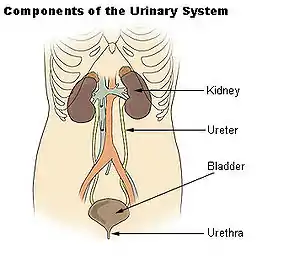Urinary bladder disease
Urinary bladder disease includes urinary bladder inflammation such as cystitis, bladder rupture and bladder obstruction (tamponade). Cystitis is common, sometimes referred to as urinary tract infection (UTI) caused by bacteria, bladder rupture occurs when the bladder is overfilled and not emptied while bladder tamponade is a result of blood clot formation near the bladder outlet.[1]
| Urinary bladder disease | |
|---|---|
 | |
| Urinary system | |
| Specialty | Urology |
Cystitis
Cystitis is a urinary bladder inflammation that results from any one of a number of distinct syndromes.[2] It is most commonly caused by a bacterial infection in which case it is referred to as a urinary tract infection.[3]
Bladder trauma
Bladder rupture (rupture of bladder, N32.4) may occur if the bladder is overfilled and not emptied. This can occur in the case of binge drinkers who have consumed large quantities of fluids, but are not conscious of the need to urinate due to stupor. This condition is very rare in women, but does occur. Signs and symptoms include localized pain and uraemia (poisoning due to reabsorbed waste).[4][5]
Intra- and extraperitoneal rupture
Bladder rupture is divided into intraperitoneal and extraperitoneal rupture, with the latter encompassing 85% of post-traumatic bladder rupture. Intraperitoneal rupture is both more rare and associated with greater morbidity, requiring surgical repair due to the risk of non-healing and gram negative sepsis.[6][7]
Bladder tamponade
Bladder tamponade is obstruction of the bladder outlet due to heavy blood clot formation within it.[9] It generally requires surgery.[9] Such heavy bleeding is usually due to bladder cancer.[10]
See also
References
- Meijlink, Jane M (April 2014). "Interstitial cystitis and the painful bladder: A brief history of nomenclature, definitions and criteria: History of IC/painful bladder". International Journal of Urology. 21: 4–12. doi:10.1111/iju.12307. PMID 24807485.
- "Cystitis Nonbacterial eMedicine". 2019-10-20. Cite journal requires
|journal=(help) - "Cystitis — MayoClinic.com".
- Lucy Atkins (2007-11-20). "A new report says binge drinking has increased to such an extent that cases of 'exploding bladders' are on the rise in the UK". The Guardian.
- Dooldeniya MD, Khafagy R, Mashaly H, Browning AJ, Sundaram SK, Biyani CS (2007). "Lower abdominal pain in women after binge drinking". BMJ. 335 (7627): 992–3. doi:10.1136/bmj.39247.454005.BE. PMC 2072017. PMID 17991983.
- Vaccaro, JP; Brody, JM (2000). "CT cystography in the evaluation of major bladder trauma". Radiographics. 20 (5): 1373–81. doi:10.1148/radiographics.20.5.g00se111373. PMID 10992026.
- Simon, LV; Hashmi, MF; Burns, B (January 2019). "Bladder Rupture". PMID 29262195. Cite journal requires
|journal=(help) - "UOTW #1 - Ultrasound of the Week". Ultrasound of the Week. 19 May 2014. Retrieved 27 May 2017.
- Page 352 in: Guenter Schmidt (2006). Differential diagnosis in ultrasound: a teaching atlas. Stuttgart: Thieme. ISBN 3-13-131891-0.
- Miyamae, K.; Otsuka, T.; Otsuka, Y.; Nagayoshi, M.; Hamada, Y. (2006). "Clinical study of bladder tamponade resulting from clots of blood". Nihon Hinyokika Gakkai Zasshi. The Japanese Journal of Urology. 97 (5): 743–747. doi:10.5980/jpnjurol1989.97.743. PMID 16898598.
External links
| Classification |
|---|
| Wikimedia Commons has media related to Diseases and disorders of the human urinary bladder. |